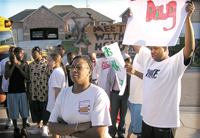Chicago
The Southwest Youth Collaborative is housed in a corner building covered by graffiti murals and perched at the junction of several ethnic neighborhoods on Chicago’s Southwest Side. Martin Luther King Jr. marched through these neighborhoods in 1966 – when they were all-white – in his campaign for open housing, and was knocked to the ground by a rock thrown by one of thousands of angry white protesters. King later said the racial vehemence in Chicago was the fiercest he’d seen anywhere.
Today, the neighborhood schools that were once the targets of bitter desegregation protests are filled with black, Latino and Arab youth. Almost 40 years after King was hit by the rock, the Southwest Youth Collaborative guides many youth in grappling with racism in a way that few youth development programs do.
 While many programs touch on race, here that subject permeates almost every activity. Through its Generation Y program, the collaborative’s youth workers teach kids about racial history. The youths then go beyond complaining about racist incidents around them by examining cultural, historical and other unseen factors behind those incidents. Then they take action, from rallying against racial profiling to more subtle efforts, such as arranging apprenticeships for black girls to learn to run businesses.
While many programs touch on race, here that subject permeates almost every activity. Through its Generation Y program, the collaborative’s youth workers teach kids about racial history. The youths then go beyond complaining about racist incidents around them by examining cultural, historical and other unseen factors behind those incidents. Then they take action, from rallying against racial profiling to more subtle efforts, such as arranging apprenticeships for black girls to learn to run businesses.
The collaborative is among about 20 youth-serving organizations that have recently been cited as models for addressing racism, in two reports that raise questions about how aggressively youth-serving programs should deal with race.
When it comes to dealing with race, says a report this year from the Aspen Institute Roundtable on Community Change, most youth development programs share a shortcoming: They derive from a “race-neutral premise” and focus on fixing individual, family and neighborhood problems in order to help youth become productive adults. The programs focus on changing youths’ behavior, giving them skills and connecting them to community resources.
All of which is good, some observers say, but ignores a bigger problem: that racism is built into American society in ways that people aren’t aware of or willing to acknowledge. They advocate youth work that is based on a theory of “structural racism,” which essentially says American society is inherently racist in its history, culture and processes, and that youth must be taught to change the fundamental ways society thinks and functions.
“Unless we identify and address the manifestations of structural racism, we may help youth do better in spite of a set of pernicious mechanisms that sort them by race, but we will not change the fundamental conditions that help produce and maintain racially disparate outcomes,” says the Aspen report, “Structural Racism and Youth Development.”
Not everyone agrees with the structural racism theory, and using it as a basis for youth work is difficult. “It’s not a mainstream idea, that’s for sure,” says Keith Lawrence, a research associate at Aspen and co-author of the report.
The Rev. Jesse Lee Peterson, a conservative African-American commentator, says theories such as institutional and structural racism are based on outdated ideas about an inherently racist society that do not reflect the society in which most American youth live today. Peterson, whose Los Angeles-based Brotherhood Organization of a New Destiny operates a group home for teenage boys and young men, says academicians are trying to “brainwash kids into believing” that racism is a dominant factorin their lives.
Structural Racism
The first challenge for anyone interested in the structural racism theory is to figure out what it means.
Consider Aaron Fowler, whose organization, Hope Street Youth Development, in Wichita, Kan., was hailed last year in a report about structural racism by the Youth and Racial Equity Project. “I’m still not sure how the heck we systematically are looking at the problem of structural racism,” he says. “I don’t see what we’re doing as looking specifically at racism. What we look at is injustice.”
Structural racism sounds like institutional racism, which refers largely to racially disparate outcomes that result from the ways organizations such as banks, government agencies and schools do business. But structural racism is larger and more amorphous; it is not about visible incidents, but about processes and ways of thinking that lead to those incidents.
It “refers to the way in which history, public policies, institutional practices, and cultural stereotypes and norms interact to maintain racial hierarchies and inequitable racial group outcomes,” Lawrence wrote in a working paper in 2000.
“It’s more in the realm of social psychology, more in the realm of beliefs and values and assumptions,” he says.
The results of this process, says the Aspen report, are evident in education (such as low spending in poor districts), juvenile justice (such as the disproportionate detention of black youth), media portrayals of minorities (such as crime coverage), political representation, health care and employment.
Peterson sees that as a lot of theoretical gobbledygook promoted by old-style civil rights leaders who peddle racial schisms. Teaching youth that society is inherently and fundamentally biased against them “tends to bring on anger and hold them back in life,” says Peterson, who has been hailed by the conservative Heritage Foundation think tank as part of the “new black vanguard” of conservative African-Americans. He says that for most youth, “their mindset is not about race anymore. It’s more about competing to do the best thing.”
Even those in the youth field who agree that youth development programs should do more to help youth confront racism face a significant dilemma: the very way youth development programs operate.
Where Youth Development Fits
Most youth development programs are not fundamentally created or funded to orchestrate structural community or social change; they aim primarily to improve society by helping youths grow into responsible adults. “Youth development programs still overwhelmingly focus on the individual youth as the primary ‘unit of change,’ ” says the Racial Equity Project report, “Changing the Rules of the Game: Youth Development & Structural Racism.”
To be sure, the Aspen report notes, many youth development programs work on racial issues, such as documenting “misrepresentations of young people, particularly those of color, in the media” and leading campaigns “to protest punitive and discriminatory policies in school systems and in the juvenile justice system.”
But when youth development programs confront race, they often do so through finite events and initiatives such as rallies, skits and multiracial gatherings. The Racial Equity Project report notes that during one of the project’s discussions among youth organization leaders about racism, “when one group talked about trying to ‘do something’ by sponsoring cross-cultural recreational activities, another group responded that ‘bowling is not the answer.’ ”
Many youth programs also teach youth how to deal with racism by an individual, such as a co-worker – a good skill that nevertheless might not address the systemic problem. At Leadership Excellence in Oakland, Calif., Executive Director Dereca Blackmon refers to an adage about the drawbacks of teaching resiliency in the face of discrimination: “Resiliency says when society is standing on your neck, develop a stronger neck. We want you to have a stronger neck, but we also want you to be part of making the change that gets the foot off your neck.”
The key, say the recent reports, is teaching youth to analyze incidents, patterns and causes.
“The concept of structural racism is more a diagnosis of the problem than it is a framework for action,” says Lawrence at Aspen.
This diagnosis is sometimes done through workshops and retreats. At Leadership Excellence each summer, about seventy 14- to 18-year-old African-American youths attend a “personal change” retreat that covers issues such as sex, violence and, for one of the six days, racism. The discussion leads to a re-enactment of the African slave trade, with blindfolded youth being marched into an auction and sold. They also do a workshop “around the use of the N word,” including its history, Blackmon says. “For the first time in many of the young people’s lives that they have heard the N word in context.”
At Generation Y in Chicago, the discussions try to push youth beyond the observation that an action or person is racist, to analyze the underlying process. “We take a real-life situation that kids might be familiar with – a kid got suspended because he had a marker in school – and make a scenario out of it,” says Corina Pedraza Palominos, a lead organizer with Generation Y.
If the youth say something like, “That teacher is clearly racist,” Palominos says, “our challenge is to ask questions and agitate: ‘Well, is the teacher being racist? Or is the teacher carrying out a policy that is racist? And what happens when a whole system is using that policy to push out black and Latino kids – what do we call that?’
“It’s really engaging them in critical thinking.”
Such discussions show that youth development programs don’t have to turn themselves into rabble-rousing youth organizers in order to confront racism in a more in-depth way, says Lori Villarosa, director of the Philanthropic Initiative for Racial Equity and one of the authors of the Racial Equity Project report. She says youth development programs “can be strengthened by recognizing and being a little more explicit” about the role of racism in the lives of the youth they serve.
Karen Fulbright-Anderson, co-director of Aspen’s Roundtable on Community change and co-author of its recent race report, says numerous situations in kids’ everyday lives provide openings for such discussions: “Kids coming out of neighborhoods where people have to go to check-cashing [businesses] instead of banks. Housing conditions. How some school districts have more punitive disciplinary polices than other school districts.”
Taking Action
Nevertheless, advocates of stronger anti-racist youth work say it’s best when youth build on their discussions to press for change – so that they have both “an understanding [of racism] and the power to address it,” Villarosa says.
In Portland, Ore., Sisters in Action for Power, an intergenerational civic engagement agency, led a community group that used reports about sexual harassment of black girls to organize a campaign that compelled the school district to develop new anti-harassment measures. Generation Y has held rallies in Chicago against racial profiling and passed out “know your rights” cards to young people to use when they get stopped by police.
Although not every campaign has to be primarily about race, advocates of this approach say kids should understand how race fits into every issue they work on. At the Urban Underground in Milwaukee, Co-Director Reggie Moore told the Racial Equity Project that when youth look at issues such as voter turnout, shootings by police and youth homelessness, they look through “a racial lens.”
Looking at everything through such a lens carries some risks, such as always seeing yourself as a victim who’s not responsible for your failures, and offending whites with a message that their achievements are all the result of exploiting minorities.
“It’s really important not to talk about structural racism in a way [that] assigns guilt to whites,” Lawrence says. Especially since one of the challenges to confronting racism in this way is, as he puts it, getting “more white people and more white organizations to talk about race and examine race, even though they believe it doesn’t apply to them.”
Fulbright-Anderson hopes the concept of structural racism allows people of different races to discuss the issue in a way that’s not offensive to one group, because it focuses not on individual blame but on the larger forces of society.
The kids at Hope Street were aware of the risk in 2003, when they wanted the schools to reduce the disproportionate suspensions of black youth. “We didn’t want to start with the suspensions and expulsion at a race level,” Fowler says. “We had to reframe the issue so the white folks in the suburbs could buy into” the idea that this was a problem for everyone, not just minorities.
Through a statistical report and conversations with school officials and the public, the youths stressed that suspending and expelling students hurts the school district’s graduation rate – already a matter of concern among officials – because so many of the disciplined students drop out.
“We said, ‘Listen: If you provide alternatives besides just kicking them out, it’s in your self-interest. You’re going to have more kids graduating, ’ ” Fowler recalls. The district developed new polices that included alternatives to suspension.
That’s an example of leading minority youth beyond anger and resignation by teaching them how to take responsibility for making changes. Hope Street is well-positioned for such action: It provides youth development services such as tutoring and service learning, along with youth organizing.
“The key is that our youth organizing is more than just a neighborhood cleanup,” Fowler says. “It’s changing policies and laws – systematic and structural changes that affect more than two or three people.”
Patrick Boyle can be reached at pboyle@youthtoday.org.
Resources
Dereca Blackmon, Executive Director
Leadership Excellence
Oakland, Calif.
(510) 267-9770
Aaron Fowler, Executive Director
Hope Street Youth Development
Wichita, Kan.
www.hopestreet.com
(316) 263-7325
Karen Fulbright-Anderson, Co-Director
Keith Lawrence, Research Associate
Aspen Institute Roundtable on Community Change
New York, N.Y.
www.aspeninstitute.org
(212) 677-5510
Corina Pedraza Palominos, Organizer
Southwest Youth Collaborative
Chicago, Ill.
www.swyc.org
(773) 476-3534
Lori Villarosa, Director
Philanthropic Initiative for Racial Equity
Washington, D.C.
www.racialequity.org
(202) 466-3434
Reports
“Structural Racism and Youth Development: Issues, Challenges, and Implications”
The Aspen Institute Roundtable on Community Change
publications@aspeninstitute.org
(410) 820-5338
“Changing the Rules of the Game: Youth Development & Structural Racism”
Youth and Racial Equity Project
Washington, D.C.
(202) 466-2735
www.racialequity.org
“Short Changed: Foundation Giving and Communities of Color”
Applied Research Center
Oakland, Calif.
(510) 653-3415
www.arc.org































